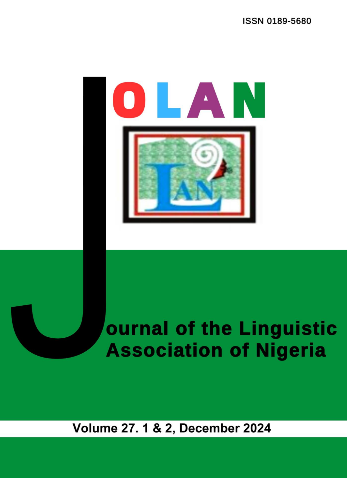Silence as a Message Conveying Process: A Hausa-Yorùbá Paradigm
Keywords:
Discourse Analysis, Silence, Discursive Silence, CultureAbstract
Usually, the picture that comes to the human mind at the mention of the word, silence, is absence of sound. This could be linguistically explained as a situation where nothing is uttered. In a way, it may be counted as something out of place when it comes to achieving a communication purpose in discourse as it is believed that speech is central in this regard. Meanwhile, during discourse, apart from speech, several discursive strategies including silence are usually exploited by interlocutors to maximise their communicative competence regardless the language(s) they use. It is not surprising then to identify certain instances in which speakers of Hausa and Yorùbá languages exploit this process to covey messages during linguistic interaction. Precisely, the reality of this is
culture specific and thus hopeful to be meaningful enough for evaluation in actualising discourse analysis objectives especially from a Hausa – Yorùbá perspective using Clair’s (2003) provision as a theoretical framework.
References
Behnam, B. and Nosratzadegan, N. (2014) ‘A Discourse Study of Rhetorical Silence in Persian and English Literature.’ International Journal of Academic Research in Progressive Education and Development, Vol. 3, No. 4.
Bruneau, T. J. (1973) ‘Communicative Silences: Forms and Functions’: Journal of Communication, 3, 17-46.
Clair, R. (2003) ‘The Social and Cultural Construction of Silence.’ Intercultural Communication Studies as University of Louisville, 1293), 87-91.
Dressen, D. F. (2002) “Identifying Textual Silence in Scientific Research Articles: Recontextualizations of the Field Account in Geology.” In Hermes, Journal of Linguistic, No. 28
Ephratt, M. (2008) ‘The Functions of Silence.’ Journal of pragmatics, 40, 1909-38.
Faleti, A. (2003) Basorun Gaa. AFAN Productions.
Hudson, R. A. (1980) Sociolinguistics. London: Cambridge University Press.
Jorgensen, M. Phillips, L. J. (2002) Discourse Analysis as Theory and Method. London: Sage Publications.
Kalman, Y. M. (2008) Silence in Online Education: the Invisible Component]. Ph.D Dissertation, University of Haifa.
Kurzon, D. (2007) ‘Towards a Typology of Silence.’ Journal of Pragmatics, 39, 1673-1688.
Matthews, P. H. (2007) Oxford Concise Dictionary of Linguistics (2 Ed.). Oxford: Oxford University Press.
Medubi, O. A. (2010) ‘A Cross-cultural Study of Silence in Nigeria: An Ethnolinguistic Approach’ in Journal of Multicultural Discourses, Vol.5, Issue 1.
Sadeghi, L. (2015) ‘Discursive Silence: A Tool to Read between the Lines in Persians Stories.’ In International Journal of Linguistics. Mactothink Institute, Vol. 7, No 5.
Smith, P. and Bell, A. (2007) ‘Unraveling the Web of Discourse Analysis’. In Devereux, E (ed). Media Studies: Key Issues and Debates. London: Sage.
Stubbs, M. (1983) Discourse Analysis: The Sociolinguistic Analysis of Natural Language. Chicago: University of Chicago Press.
Trappes-Lomax, H. (2004) ‘Discourse Analysis’ in Davies A & Elder, C. The Handbook of Applied Linguistics. Blackwell Publishing Ltd.
Wodak, R. (1996) Disorders of Discourse. London: Longman.
Wong, N. L. (2003) Communicative Functions and meanings of Silence: an Analysis of Cross-Cultural Views. OAI.














